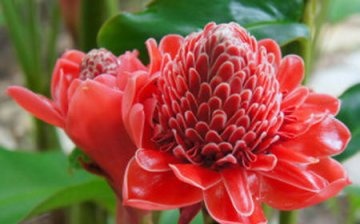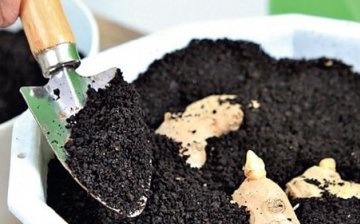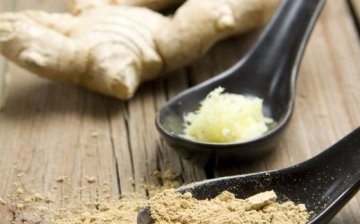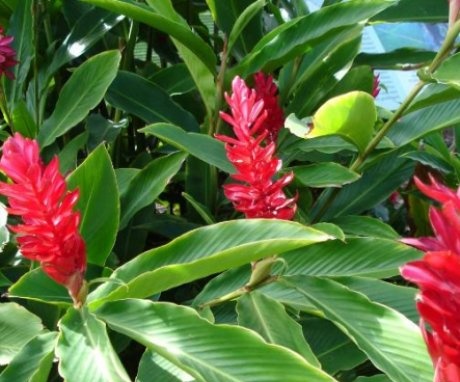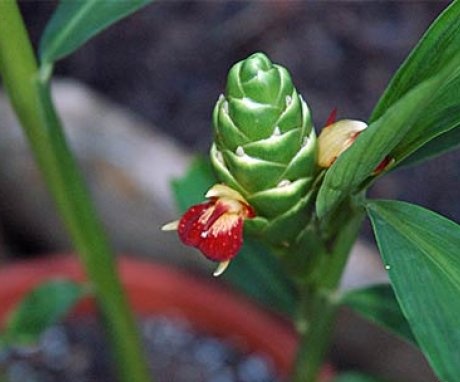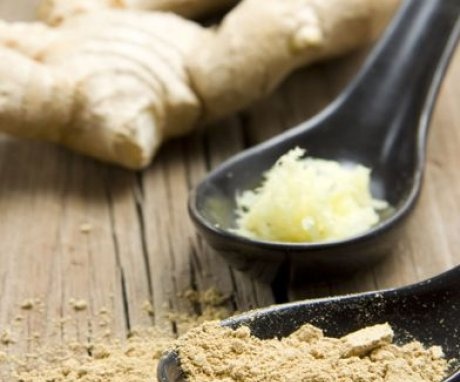Where does ginger grow and how does it bloom?
Many useful plants are used not only for medicinal purposes, but also for decorative purposes. It takes effort to make them bloom and surprise us with the beauty of their flower. Ginger is known as a medicinal plant with medicinal properties of the root. But many of its species also have an external wealth of unique inflorescences.
We know the root of ginger, but little is known about the plant itself. But there are about a thousand types of spicy culture. Ordinary ginger useful for human health, but decorative varieties will decorate the house and garden with outlandish flowers, some of them are used in cooking, medicine, cosmetology.
Content:
- Ginger flower - description, flowering time
- Conditions for growing a plant on a windowsill
- Rules for caring for indoor ginger
- Blooming ginger in the garden - how to grow
- Care Tips, Harvesting
- Useful properties of ginger and uses
Ginger flower - description, flowering time
Common ginger is credited with medicinal properties, but its flower is rather modest. And in order for the root part of the plant to bring more benefits to the person, he is not allowed to bloom.
The decorativeness of some species is expressed in the unusual structure of the flower:
- In ginger Zerumbet, large inflorescences are formed on the stems, outwardly similar to a rose with dense fleshy petals. The plant blooms for a long time.
- Wonderful ginger blooms on powerful stalks like corn cobs inflorescences of a bright pink hue.
- Orchid-like flowers in the Kasumunar variety, complex structure, white tone.
- Japanese ginger has delicate flowers with a pleasant aroma in early spring.
The flowering of any plant is an unusual sight - the ginger produces flowers on long basal stems. One inflorescence can contain petals of different shades from red and purple to yellowish. And the shape is surprising - in the form of cones, lilies. Usually the plant begins to bloom in the second or third year after planting. To admire the beauty of blooming ginger, you need to know how to grow it properly.
Conditions for growing a plant on a windowsill
Ginger plant species live in the wild in the tropics of Asia, America, and therefore it is necessary to create certain living conditions for them. It is necessary to plant the root in winter. Loose soil is added to the container. In order for the soil to pass air and water well, add a little coarse river sand or fine gravel to the finished soil. There are special requirements for a ginger pot: it must be wide, with holes in the bottom. Drainage from broken bricks, pieces of ceramics is laid out on the bottom of the container.
Rhizomes for planting are soaked in warm water to awaken the buds.
It will be enough to hold the root in liquid for a day or several hours. Planting material is planted, laid horizontally, to a depth of two centimeters. If the root is cut, leaving a part with a kidney, then the cut must be dried, sprinkled with ash or charcoal, treated with a weak solution of potassium permanganate.
In order for the root to germinate quickly, the pot with it is placed in a bright room with a temperature of at least 15 degrees Celsius, constantly moistening the soil by spraying. The first shoots appear under good conditions after four weeks. And then you need to put the container on the windowsill, where it will be sunny, but without bright ultraviolet radiation. This is usually the west or southeast side of the house. After germination ginger for it, you need to create subtropical conditions in the room - enough humidity, heat and light.
Rules for caring for indoor ginger
Plant care aims to produce a flowering plant:
- Water the flower sparingly when the topsoil dries out. Ginger does not like excessive moisture.
- It is imperative to spray the spice, creating a halo of moisture around. The procedure is useful in dry and hot weather. For spraying, use settled water at room temperature. To get moisture only on the leaves and stem, use a spray bottle.
- In order to obtain powerful peduncles feed ginger twice a month during the growing season, using potassium salt, superphosphates as part of fertilizers.
- In the fall, the number of watering is reduced, and for the winter the pot is removed to the basement until spring. At this time, the leaves and stem of the plant will dry out. Watering will need to be done up to once every two weeks.
- In March, the plant is transplanted into a new pot, changing the soil.
Ginger blooms in the second year after planting and lasts for several weeks. Some types of flowering plants are used for cutting in bouquets.
Blooming ginger in the garden - how to grow
The root planted in February or March and sprouted can be planted in open ground in a well-lit area. Before planting the culture, the earth is loosened, holes are prepared seven centimeters deep. Having placed the root horizontally, cover it with a small layer of earth.
After planting, it is necessary to water the seedlings abundantly.
If the climate is too harsh for the growth of ginger, then it can be grown in greenhouse ridges. For good development, create conditions of high humidity. In hot summer, the plant must be protected from direct sunlight.
Having chosen a convenient place for planting ginger, it must be borne in mind that it will reach maturity 8-10 months after planting. And ordinary ginger in the garden can bloom only in the third year of life.
Care Tips, Harvesting
The unpretentiousness of the spicy plant is known:
- During development, ginger requires good soil and air moisture, especially during periods of heat. Watering should be alternated with loosening the soil around the plantings. It should be shallow, but thanks to the procedure, the growth of shoots will accelerate.
- It is better to spray the leaves of the flower in the evening so as not to burn them.
- Ginger treats fertilizers positively, delighting in the future with a good harvest. Suitable as a top dressing diluted with water mullein in a ratio of 1:10 with alternating application mineral fertilizers - potassium salt, superphosphate.
Digging up the roots of the spice begins after the foliage has completely turned yellow and falls off. Rhizomes are cleaned of the ground, dried for a week outdoors under a canopy.
Proper storage of roots involves placing them in a refrigerator or basement, where the temperature should not exceed 2-4 degrees Celsius.
Fresh ginger can be used for up to eight weeks. Freezing of the product is possible, then it can be used longer. Chopped fresh ginger is suitable for preparing alcoholic tinctures, which will be needed in compresses, rubbing. Having covered the crushed root with sugar, use the mixture for brewing tea, making desserts, and drinks.
You can also dry ginger, then it can retain its beneficial properties for a long time. It remains only to add a pinch of spice to tea, soup, salads, main courses. The piquancy of food with ginger has been known for a long time and enjoys well-deserved popularity.
Useful properties of ginger and uses
Even in ancient times, ginger root was considered a universal medicine:
- Potions prepared from the plant help patients suffering from diseases of the gastrointestinal tract.
- The ten antiviral compounds available in the plant are used in therapy for any viral infections.
- The bitterness of the product as a result of the presence of a phenol-like substance expels parasites from the body.
- Essential oils in ginger are needed to calm the nervous system, lower blood pressure, normalize blood circulation, and prevent blood clots.
- Asian peoples use the root to improve memory, relieve motion sickness symptoms.
- Wounds are sprinkled with ginger powder, compresses are made on inflamed joints for arthrosis and arthritis.
- To prepare ginger tea, you need to take a teaspoon of powder, pour two glasses of water and boil for forty minutes. Sugar is added to the strained drink and drunk after meals to relieve the feeling of heaviness in the stomach, eliminate nausea, vomiting.
- When signs of a cold appear, two pieces of ginger root are poured into a glass of water, boiled for ten minutes, and taken daily.
- Ginger oil is used during massage of diseased areas of the skeletal system. And by dropping two drops on a sugar cube or mixing them with half a teaspoon of honey, they are taken for flatulence, indigestion, spasms of pain during menstruation.
- Essential oil is used for inhalation when the voice is lost, the tonsils are inflamed.
- It is useful to add ginger to dishes during fasting days. It helps to break down subcutaneous fat accumulations, smooth and tighten the skin.
Culinary experts use seasoning in the preparation of jelly, compotes, add to baked goods. As with the use of any medicinal plant, you need to know about the side effects of the root, use it within reasonable limits.
More information can be found in the video:



